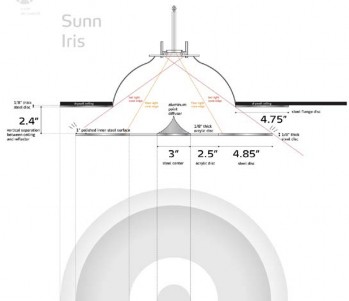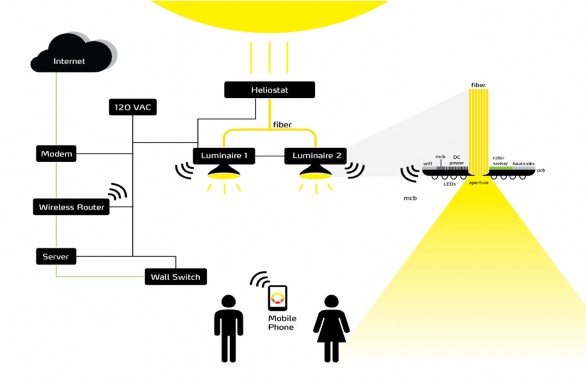Grantee Research Project Results
Final Report: Hybrid Fiber Optic LED Lighting
EPA Grant Number: SU835323Title: Hybrid Fiber Optic LED Lighting
Investigators: Schneider, David R , Choi, Jong Hoon , Hedge, Alan , Hssaine, Camelia , Pollock, Cliff , Chang, Flora , Blum, Jeremy , Elliot, John , Ciecholewski, John , Brown, Josh , Minor, Kelton , Kliewe, Oliver
Institution: Cornell University
EPA Project Officer: Hahn, Intaek
Phase: I
Project Period: August 15, 2012 through August 14, 2013
Project Amount: $15,000
RFA: P3 Awards: A National Student Design Competition for Sustainability Focusing on People, Prosperity and the Planet (2012) RFA Text | Recipients Lists
Research Category: Pollution Prevention/Sustainable Development , P3 Awards , P3 Challenge Area - Air Quality , P3 Challenge Area - Sustainable and Healthy Communities , Sustainable and Healthy Communities
Objective:
We have created a fiber optic hybrid lighting system that uses LEDs and flexible optical fibers to collect, transport and distribute the sun’s light from building exteriors to interior spaces. Although the concept of fiber optic daylighting has been approached before, the innovation of the project lies in its ability to not only transfer natural daylight from exterior spaces to enclosed interiors but also to supplement this light when needed with state-of- the-art tunable LED fixtures that can match and maintain the color distribution and illumination of daylight.
Summary/Accomplishments (Outputs/Outcomes):
There are 5 main components to this project.
-
The sunlight collector which uses a heliostat to track the sun throughout the day and is located on a building's roof or façade. The sunlight collector also has a lens array to focus the sun onto the fiber optic cables.
-
The fiber optic cables which are transmits the incident sunlight from the exterior into a building's deep interior spaces.
-
The luminaire which distributes the available sunlight and supplements it with LED lighting when necessary.
-
The lighting control system which optimizes the lighting condition based on available sunlight, matches the lighting to the sun's position in the sky, wirelessly coordinates multiple light fixtures, allows a user to control everything from a web or phone app.
-
A lighting exhibit which is a small room used to display the luminaire and to perform lighting quality and human factors tests.
The luminaire is designed to maximize the light available from the fiber optic bundle so that it fills the room with as much natural sunlight as possible. The image below of the hybrid luminaire.

Figure 1: Hybrid Lumunaire.
The hybrid luminaire is responsible for funneling in light from the fiber optics, attenuating it with an aperture, and augmenting it with color-tuned LEDs. An onboard microcontroller controls the LEDs and facilitates communications with an onboard WiFi radio for communication to the control server. See below for the electronic system diagram.

Figure 2: Electronic System Diagram.
Conclusions:
The project balances the elements of people, prosperity, and the planet with an environmentally sustainable product that enhances the human experience of indoor lighting. By adding focus to the quality of the light, the Hybrid Lighting system is capable of producing light that is more comfortable to people, mimicking natural outdoor light. It also reduces consumption by drawing light directly from the sun – a 100% renewable source.
The project was partially successful in terms of the Phase I proposal. Although the full fiber optic solution may not always be the best solution, as shown in our trade-off study, Our research of human factors and the photo-biological benefits of light led to a LED lighting system that could modulate color temperature and brightness to improve the quality of the indoor environment. This LED lighting system alone is a significant success that could have valuable impacts as suggested below.
Supplemental Keywords:
Active and passive daylighting, full spectrum lighting, energy efficiency, lighting controlsThe perspectives, information and conclusions conveyed in research project abstracts, progress reports, final reports, journal abstracts and journal publications convey the viewpoints of the principal investigator and may not represent the views and policies of ORD and EPA. Conclusions drawn by the principal investigators have not been reviewed by the Agency.
